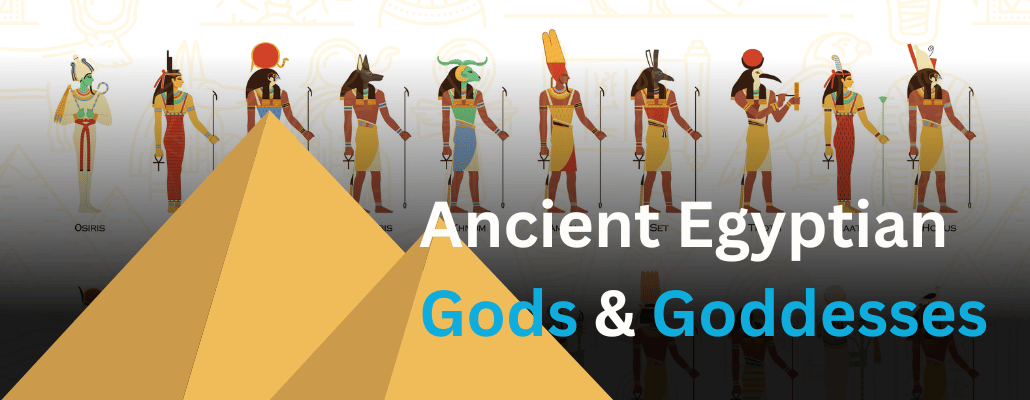Explore Ancient Egypt
- Ancient Egypt Facts
- Ancient Egypt Timeline
- Hieroglyphics
- Egyptian Gods & Goddesses
- Pharaohs
- Notable People (Cleopatra etc.)
The Ancient Egyptians were a civilisation dating as far back as the 4th millennium BC (that’s a LONG time ago), which makes it even more incredible that so many of their monuments and art have survived.
They are well known for loads of amazing creations, from gigantic pyramids to the intricate (and a bit gross) mummification process and amazing hieroglyphics. Archaeologists are still learning new things about the Egyptians, and one fascinating aspect of their history is their religious belief system.
Ancient Egyptian religion was what we call polytheistic (they worshipped many Gods instead of one God) and it had one of the largest number of Gods and Goddesses in the ancient world – over 2,000 of them! Each God had its own characteristics, and most of them had the body of a human and the head of an animal.
Here is a list of 13 Gods and Goddesses any why they were worshipped – see which ones you’ve heard of and which are brand new to you!
Ra – God of the Sun
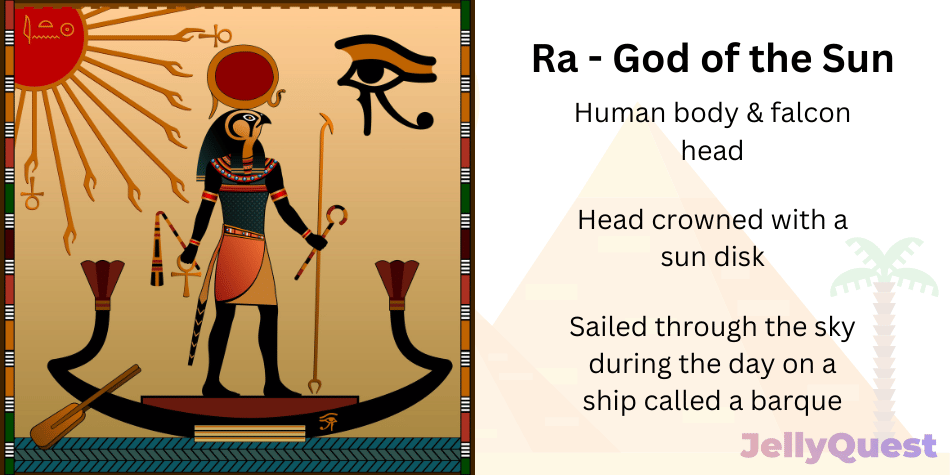
For many Ancient Egyptians, Ra was the most important God – God of the sun and lord of all the other Gods. He was usually shown with human body and a falcon head. His head was crowned with a sun disk (hence sun God!) which was encircled by a sacred cobra called the Uraeus.
The Egyptians believed Ra sailed through the sky during the day on a ship called a barque, and passed through the underworld at night, ready to appear the next day. The sun itself was believed to be either his body or his eye.
The Goddess of the sky was called Nut (we’ll learn more about her later), and it was believed she swallowed Ra each night, which is why he went to the underworld, and why night arrived.
Anubis – God of the Dead
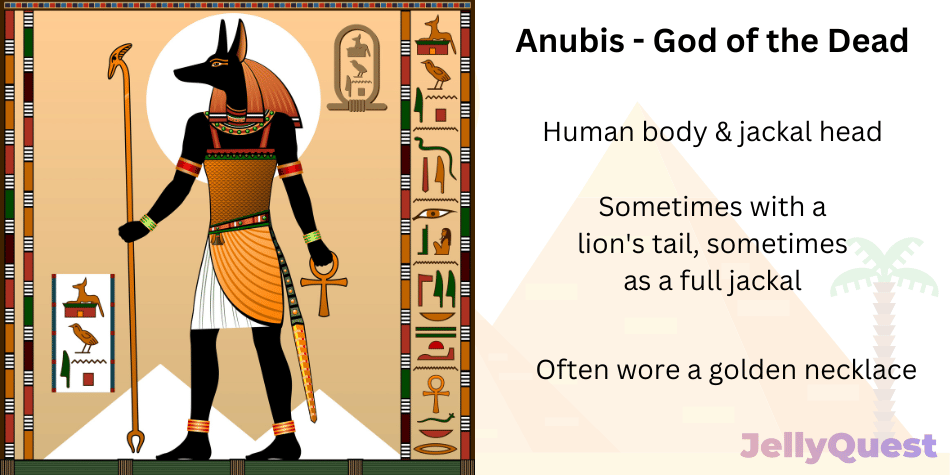
There are many reasons we know the Ancient Egyptians believed in a life after death, and one of them is Anubis. Anubis was the God of the dead, and is one of the reasons Egyptians were mummified.
He was usually depicted with a human body, a jackal’s head and a lion’s tail, although sometimes he was shown as a full jackal. He often had a golden necklace on. Before Osiris rose to prominence as the God of the underworld, Anubis was the main God of the dead, and was very, very important.
Ancient Egyptians believed that you needed to live a good and honest life, otherwise Anubis might send you to be eaten – ouch!
Osiris – God of the Underworld
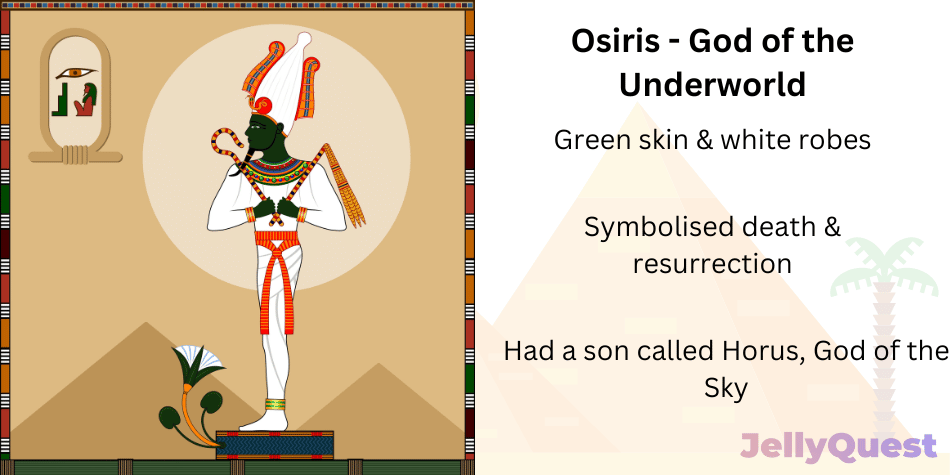
Another super famous God, Osiris ruled the Underworld, which is the place where Egyptians believed they went after they died. He not only symbolised death, but also resurrection, and was also linked to the yearly flooding of the river Nile which was relied on for agriculture and the continued prosperity of society.
According to Ancient Egyptian myth, Osiris was a King of Egypt who was murdered by his brother Set who then dismembered him (gross). His wife Isis reassembled his body and resurrected him, bringing him back to life (we love a happy ending)! They went on to have a son, another God called Horus.
Osiris was depicted with green skin (a symbol of rebirth) and white robes (a symbol of mummification) and had a headdress called the Atef crown. Of all the Gods, Osiris was one of the closest connected to the Pharaohs. The Egyptians believed in something called Divine Kingship, and like the Kings and Queens of modern history, Pharaohs weren’t just heads of state, but religious leaders too – considered directly connected to the Gods.
Horus – God of the Sky
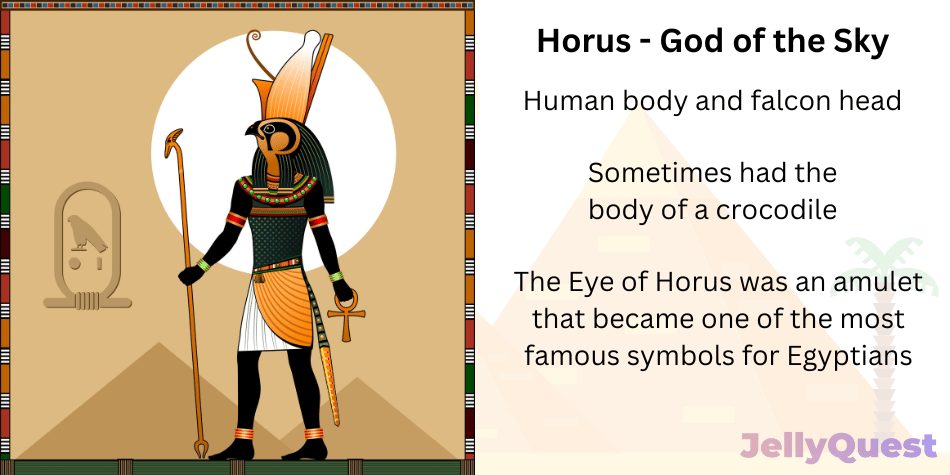
We’ve already gone through how Horus was born (being the son of a murdered then resurrected King is certainly a cool story to tell round a dinner table!), but the son of Isis and Osiris has his own interesting story.
His uncle Set had killed his dad Osiris, so it’s not that surprising the two had beef! After fighting and defeating Set, Horus became King and God of the sky! He was considered to be very handsome, and was usually shown with a human body and a falcon head, although sometimes he had the body of a crocodile!
We’ve already mentioned the falcon-headed god Ra, and there were many falcon related Gods, but for many Egyptians, particularly in the towns of Pe Bendet and Khem, Horus’ symbolism ended up encompassing them all. In life, ruling Pharaohs were seen in the image of Horus, and became Osiris after death.
The Eye of Horus was an amulet that became one of the most famous symbols for Egyptians. It represented protection, and was believed to fight off danger, evil and disease.
Isis – Goddess of Good Fortune
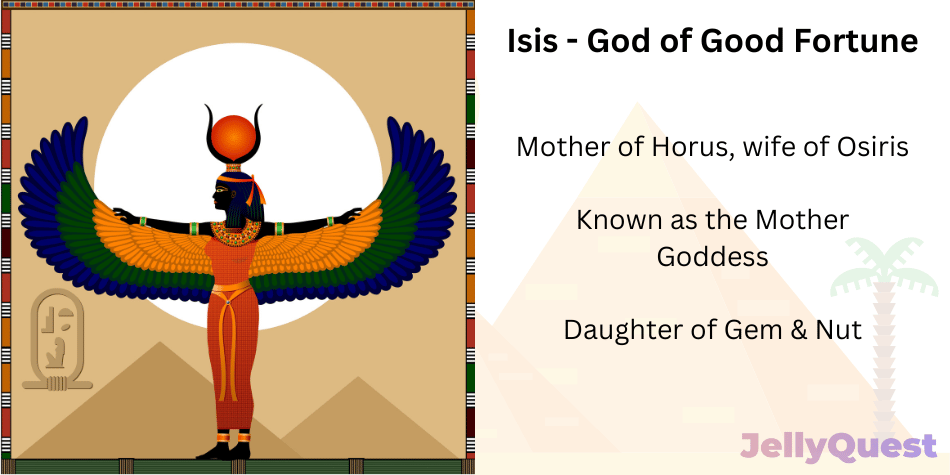
Mother of Horus, wife of Osiris and a powerful Goddess in her own right, Isis was known as the Mother Goddess and it was believed that she helped people pass through to the afterlife (the underworld) when they died.
She’s been linked to many things over time, including protection, healing, motherhood and nature. Although we usually know her as Isis now, this is actually the Greek translation. Ancient Egyptians would have known her as Aset or Iset.
Isis was the daughter of Gem and Nut (more from them later) and legend has it that she had a sister Nephthys and two brothers Osiris and Set. If you recognise their names from before then yep…that means she married her brother! The less said about that the better…
Even so, she was one of the most popular Goddesses in the ancient world and was worshipped as far and wide as mainland Europe, Britain and Asia Minor. The Roman Empire continued to pay homage to her too.
Nut & Geb – Goddess of the Sky & God of the Earth
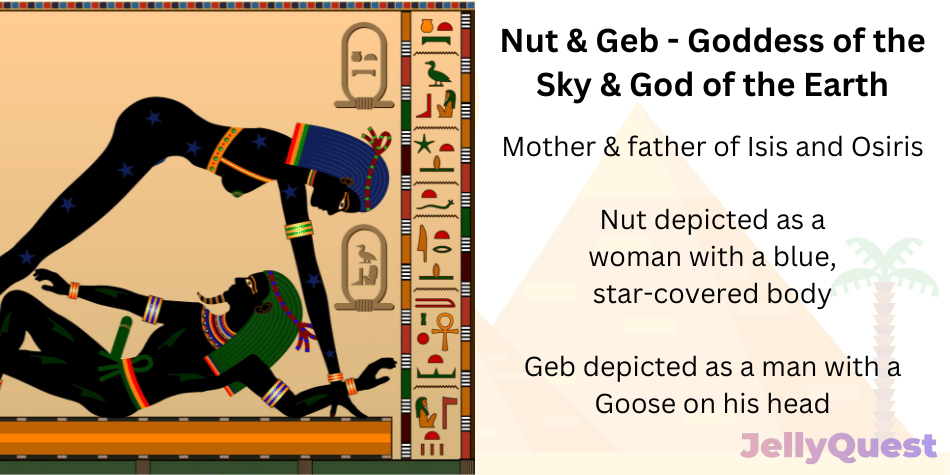
The mother and father of Isis and Osiris! And…also brother and sister. Nut was the Sky-Goddess who was depicted as a woman with a blue, star-covered body that arched over the world, supporting the sky with her back. Geb was depicted as a man with a Goose on his head, often drawn lying below Nut. It was said that his laughter caused earthquakes.
The story goes that Nut and Geb got married without asking the sun God Ra, and he got so angry that he forced their father to separate them and stopped Nut from being able to have any children throughout the year. However, the divine scribe Thoth took pity on them and tricked the moon into playing a game of draughts with the prize being the Moon’s light. He ended up winning so much light that the Moon ended up adding five whole days to the calendar, which meant Nut and Geb could finally have children!
Amun – God of the Air
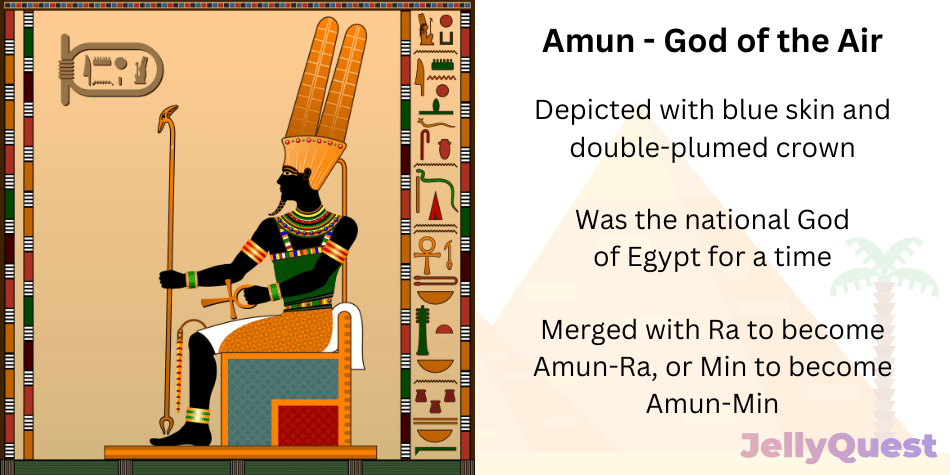
Amun was the God of the air, sun and sky. He is most commonly depicted with blue skin and a double-plumed crown, but has also been shown with a frog’s head and a ram’s head.
He started as a smaller, local God, but rose to prominence to become one of the most important, and for a time, the national God of Egypt! He has even been merged with the sun God Ra to become Amun-Ra or the fertility God Min, becoming Amun-Min.
Amun is an important example of how the meaning and importance of various Gods and Goddesses changed over time as society grew and changed.
Thoth – God of Knowledge

Thoth is usually shown with a human body and the head of an ibis which is a bird with a curved beak. The bird head often has a crown. He was originally seen as a moon God (hence the moon shaped beak) but grew to mean much more, becoming the God of knowledge, wisdom and hieroglyphs.
He’s known as the “God without a mother” and was believed to either be born from the lips of the sun God Ra at the beginning of creation, or that he created himself! Sure, both are cool, but it’s SUPER impressive to create yourself!
He was a very powerful deity who was responsible for the creation of the heavens and the his writings were supposedly collated to form the Book of Troth. Legend had it that if you read it you’d get magical powers, but you’d also be cursed to a life troubled by disaster so maybe it wouldn’t have been worth the read…
Sekhmet – Goddess of War
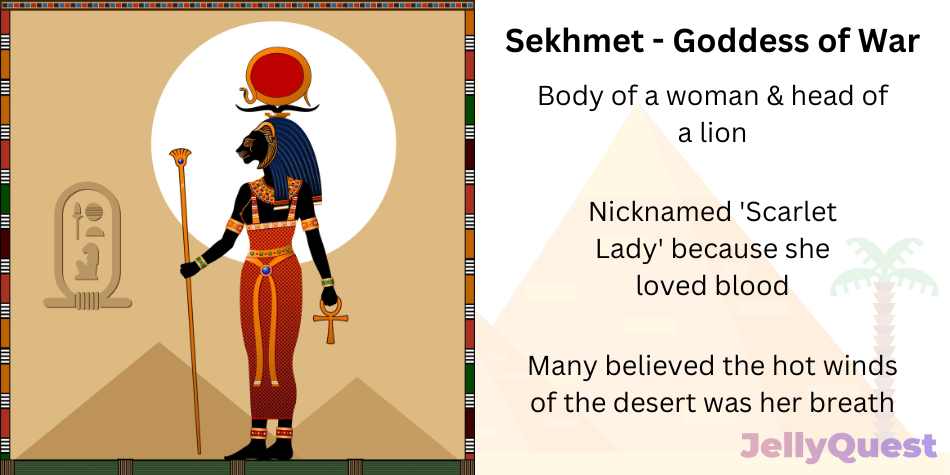
Another Goddess whose spouse was also their sibling, Sekhmet is one of the oldest and most powerful Egyptian Deities. Her name comes from the Egyptian word Sachem which means power, or might, and she was normally drawn with the body of a woman and the head of a lion!
Her power was not only connected to man-made instruments like arrows and darts, but also the devastating force of the sun’s heat. Many believed that the hot winds of the desert represented her breath and she was thought to be the daughter of Ra.
One of Sekhmet’s nicknames was the “Scarlet Lady” because she loved blood so much, and because of this, Ancient Egyptians would offer her sacrifices to please her after the violence and destruction of war. One thing’s for sure, you wouldn’t want to cross Sekhmet!
Set – God of the Desert and Chaos
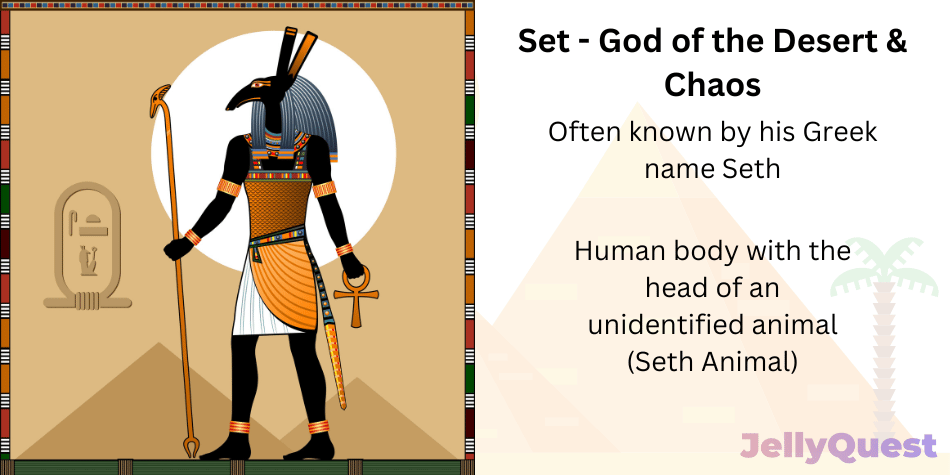
Often known by his Greek name Seth, Set is the infamous brother and killer of Osiris! He battled with his own family and represented everything that threatened harmony. Starting as a popular and revered God, he fell out of favour as Egyptian society changed, and started to be seen as an enemy.
Often connected to the colour red, Set represented drought. He was linked to many different animals over time including the antelope, the bore, the hippopotamus, and he was also compared to poisonous creatures like snakes and scorpions.
Most pictures show Set as a man with the head of an unidentified animal called the Seth Animal, and even with violent and deadly connotations, many Pharaoh’s held great respect for him and his authority. Some – like Seti I – even named themselves after him, or used the Seth animal head as part of their emblem!
Ptah – God of Craftsmen
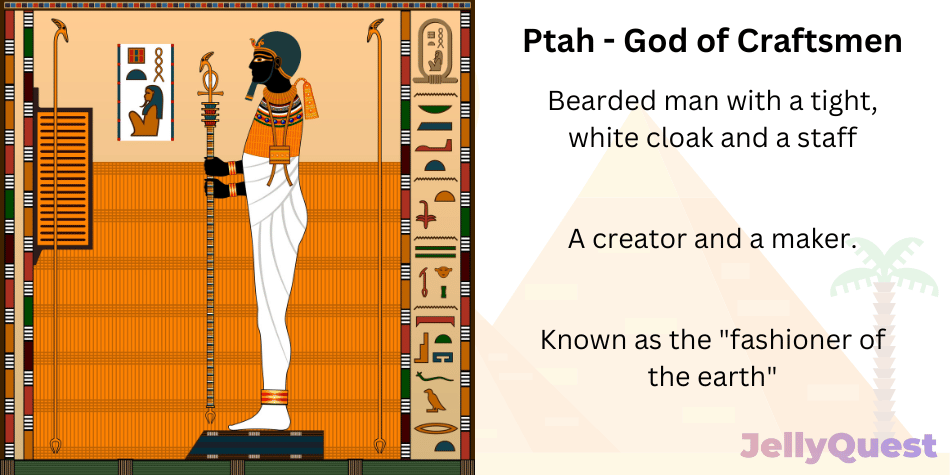
A unique-looking God, Ptah was mostly depicted as a bearded man wearing a tight white cloak and carrying a staff. He was mostly linked to being a creator and a maker, which is interesting because he was also the companion of Sekhmet, the Goddess of war. Pretty sure we can guess who was the chill one in that relationship!
Many knew him as the “fashioner of the earth” and the founder of intelligence, and he became the patron of craftsmen and women. His mummy-like clothing also connected him with the underworld, and it was believed that he opened the mouths of people who had recently died to restore the senses of the dead, looking after souls as they passed into the afterlife.
Hathor – Goddess of the Sky and Fertility

Last but not least in our list is Hathor (sometimes spelt Athor), a fun-loving Goddess connected not only with fertility and the sky, but also with music, laughter and fun! She was often shown as a woman with cow’s horns, and a solar disk between them.
Hathor was known to be nurturing, playing instruments that sent evil spirits away and protecting people after death (anyone carrying her clothing was said to be safe in the underworld). She was also believed to protect women in childbirth.
But she wasn’t all smiles and dancing – one myth goes that the sun God Ra became so angry with humanity that he sent Hathor to destroy mankind. She transformed into the Goddess Sekhmet and set out on a path of destruction, toppling entire cities and killing anyone she met.
She was so good at being bad, that eventually the other Gods pleaded with Ra to make her stop and they had to hatch a plan to end the bloodshed. They managed it with a very strong beer!
Well, we suppose too much revelry can sometimes end in tears…eek!
We’ve learnt a lot about the Gods and Goddesses of Ancient Egypt and yet we’ve barely scratched the surface – 13 down, over 1900 to go! Like many polytheistic religions, the depictions and utilities of each God often changed over time.
Unlike more modern monotheistic religions like Judaism, Christianity or Islam, the Ancient Egyptians connected specific Gods to different aspects of nature, life and death.
There are so many more that we couldn’t possibly list all of them, but of the Gods we’ve covered above, who is your favourite, and why do you think they’re so cool?
Ancient Egyptian God & Goddesses FAQs
What are the main gods & goddesses of Egypt?
Ennead, also known as Great Ennead, consisted of 9 deities (gods & goddesses). These were Atum, Shu, Osiris, Isis, Geb, Nut, Set, Nephthys and Tefnut.
Who is the most powerful Egyptian god or goddess?
Amun was considered one of the most powerful and popular gods. He even merged with the sun God Ra to become Amun-Ra, or the fertility God Min, becoming Amun-Min.
How many Egyptian gods and goddesses are there?
There were over 2,000 deities (gods and goddesses) that were worshipped by the Ancient Egyptians. Ancient Egyptian religion was what we call polytheistic (they worshipped many Gods instead of one God) and it had one of the largest number of Gods and Goddesses in the ancient world
Who was the first Egyptian God?
Atum, also known as Atem or Tem, is considered the first and the most important Ancient Egyptian God.
Who is the coolest Egyptian god?
Ra, God of the Sun, not only looked cool with his human body and falcon head, he was also the creator God and king of the deities.
